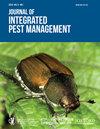Management of the Boll Weevil (Coleoptera: Curculionidae) in the Colombian Caribbean: A Conceptual Model
IF 2.7
3区 农林科学
Q1 ENTOMOLOGY
引用次数: 6
Abstract
The boll weevil [BW; Anthonomus grandis grandis Boheman (Coleoptera: Curculionidae)] is the main pest in the cotton-producing regions throughout the Americas from Southern Texas to Argentina. In the Colombian Caribbean, frequent population outbreaks have resulted in cotton planting bans in some localities and in massive applications of insecticides elsewhere (up to 15 insecticide sprays per cotton season). To date, information on boll weevil management strategies in Colombia is only available in the forms of gray literature (technical reports) and informal knowledge held by crop advisors and farmers. This study compiles this information using a standardized protocol for participatory construction of conceptual models for agricultural systems. The conceptual model developed in this study integrates the informal local knowledge of crop advisors and farmers with disciplinary knowledge describing management strategies for boll weevil. The collected data were assessed and organized using a systems approach to facilitate the future development of quantitative models and allow visualization of knowledge gaps. The model includes the description of the biological and technical-decisional subsystems. The latter subsystem explains boll weevil management at two temporal-spatial scales: 1) farm (field) scale management during the cotton season and 2) a regional boll weevil suppression strategy mainly aimed at controlling the insect populations that survived the intercotton season. The development of this conceptual model allowed describing the current management strategies for boll weevil and formulating hypotheses about the effectiveness of these strategies. This conceptual model provides guidelines for future research, and it can serve as a baseline for the development of quantitative models and simulations describing the decision-making process related to the management of boll weevil in the Colombian Caribbean.哥伦比亚加勒比地区棉铃象鼻虫(鞘翅目:象鼻虫科)的管理:一个概念模型
棉铃象鼻虫[BW;波希米亚大角角蝽(鞘翅目:栉蚊科)]是整个美洲从德克萨斯州南部到阿根廷产棉地区的主要害虫。在哥伦比亚加勒比地区,频繁的人口爆发导致一些地方禁止种植棉花,而其他地方则大量使用杀虫剂(每个棉花季节喷洒杀虫剂多达15次)。迄今为止,关于哥伦比亚棉铃象鼻虫管理战略的信息仅以灰色文献(技术报告)和作物顾问和农民掌握的非正式知识的形式提供。本研究使用农业系统概念模型参与式构建的标准化协议汇编了这些信息。本研究开发的概念模型将作物顾问和农民的非正式当地知识与描述棉铃象鼻虫管理策略的学科知识相结合。收集到的数据使用系统方法进行评估和组织,以促进定量模型的未来发展,并允许知识差距的可视化。该模型包括生物子系统和技术决策子系统的描述。后一个子系统从两个时空尺度上解释了棉铃象鼻虫的管理:1)棉季农场(田)规模管理;2)棉铃象鼻虫的区域抑制策略,主要是控制棉季间存活的昆虫种群。该概念模型的发展允许描述当前棉铃象鼻虫的管理策略,并对这些策略的有效性提出假设。这一概念模型为未来的研究提供了指导,并可作为开发定量模型和模拟的基线,描述哥伦比亚加勒比地区棉铃象鼻虫管理相关决策过程。
本文章由计算机程序翻译,如有差异,请以英文原文为准。
求助全文
约1分钟内获得全文
求助全文
来源期刊

Journal of Integrated Pest Management
Agricultural and Biological Sciences-Insect Science
CiteScore
5.80
自引率
3.60%
发文量
24
审稿时长
25 weeks
期刊介绍:
Journal of Integrated Pest Management is an open access, peer-reviewed, extension journal covering the field of integrated pest management. The Editors-in-Chief are Dr. Marlin E. Rice (formerly with Iowa State University) and Dr. Kevin L. Steffey (formerly with the University of Illinois). The journal is multi-disciplinary in scope, publishing articles in all pest management disciplines, including entomology, nematology, plant pathology, weed science, and other subject areas.
 求助内容:
求助内容: 应助结果提醒方式:
应助结果提醒方式:


